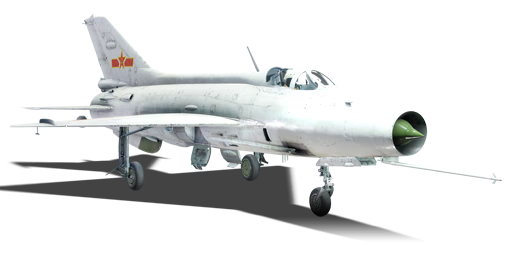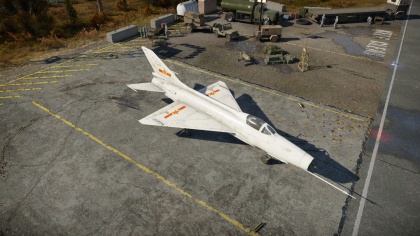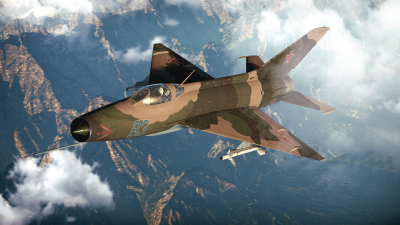Difference between revisions of "J-7II"
(→Armaments: Edits) |
(→Description) |
||
| Line 10: | Line 10: | ||
{{break}} | {{break}} | ||
The '''{{Specs|name}}''' is a rank {{Specs|rank}} Chinese jet fighter {{Battle-rating}}. It was introduced in [[Update 1.91 "Night Vision"]]. | The '''{{Specs|name}}''' is a rank {{Specs|rank}} Chinese jet fighter {{Battle-rating}}. It was introduced in [[Update 1.91 "Night Vision"]]. | ||
| + | |||
| + | After the Korean War, several nations came out with various aircraft which would out-fly opposing aircraft, especially in a dogfight. The U.S. introduced the Lockheed F-104 Starfighter and Northrop F-5 Freedom Fighter while European nations France, England and Sweden rolled out the Dassault Mirage F-1, Mirage III, English Electric Lightning, Hawker Hunter and the Saab Draken. At this time the Soviet Union was working on further developing the twin-engine MiG-19 but realized what it actually needed was a fast, single-engine light-weight fighter in what ultimately became the most highly produced supersonic fighter in the world and used by over 60 countries. This basis of this fighter was the Ye-66a (''Ye'' stands for "Yedinitsa" or single-unit), later changed to MiG-21 F-13 or as dubbed by NATO, the ''Fishbed-C''. Due to a shaky political situation, the Chengdu Aircraft Company in China reversed engineered the MiG-21 sent by the Soviet Union without technological documents. In the process they solved almost 250 inherent problems with the MiG-21, upgraded the fuel system, replaced the ejection seat and reoriented how the cockpit canopy opened. The result was the J-7 interceptor fighter that looked like the original MiG-21 with minor design and performance differences. NATO dubbed this aircraft ''Fishcan''. | ||
| + | [[File:MiG-21_smigol_chat_bann.png|400px|thumb|left|Though the '''{{PAGENAME}}''' looks almost exactly the same as the MiG-21 pictured here, the Chinese made many improvements when reverse-engineering the aircraft.]] | ||
| + | The {{PAGENAME}} was built to be a point defence interceptor, not an air-defence fighter slated for combat missions, basically a short-range day fighter. Due to being cheap, fast, inexpensive and simple to maintain, the essence of this fighter’s existence was to be used in large groups to overcome the technologically advanced Western aircraft. Essentially it was a missile which houses a pilot, two 30 mm cannon and two PL-2 air-to-air missiles. The sleek airframe was made with aluminium alloys, steel, magnesium and fibreglass. The air-intake cone automatically adjusts during the flight to help the aircraft remain aerodynamic. The fighter sported a delta wing with a 57° leading edge and even the all-moving tailplane utilizes the swept feature. Everything about this jet focus on speed which lends it reaching out to the Mach 2 range. The strength of the aircraft is its speed in a straight line whether in a climb, level flight or a dive, however, when it turns at all, it haemorrhages its energy and when it gets below 700 kph, it is difficult to get back up to speed without diving to make up that speed. When caught near the ground and going slow will be extremely frustrating for a J-7 pilot. | ||
| + | |||
| + | The {{PAGENAME}} as-built shaped like a missile excels in air-to-air combat, but beware of turning or manoeuvres, though they will slow you enough to get behind an enemy fighter, it may also slow you enough for another enemy fighter to get a missile lock or gun solution on you. Always be aware of your surroundings. Though this fighter can be outfitted with rockets or 500 kg bombs, these options should be reserved for special situations as the attacker/bomber function was never designed as a multi-role function as it was with the [[F-4C Phantom II|F-4C]]. The PL-2 missiles can be a challenge to get used to, so newer pilots may elect to outfit the HF-4 rockets and use them to go after bombers. With only 120 rounds of 30 mm cannon ammunition between the two cannons, trigger control is a must or else you will be waiting often for a reload timer to count down or will be frequently returning to base to reload. | ||
== General info == | == General info == | ||
Revision as of 20:45, 29 September 2019
Contents
| This page is about the Chinese license-built jet fighter J-7II. For original Soviet version, see MiG-21 F-13. |
Description
The J-7II is a rank VI Chinese jet fighter
with a battle rating of 9.3 (AB/RB) and 9.7 (SB). It was introduced in Update 1.91 "Night Vision".
After the Korean War, several nations came out with various aircraft which would out-fly opposing aircraft, especially in a dogfight. The U.S. introduced the Lockheed F-104 Starfighter and Northrop F-5 Freedom Fighter while European nations France, England and Sweden rolled out the Dassault Mirage F-1, Mirage III, English Electric Lightning, Hawker Hunter and the Saab Draken. At this time the Soviet Union was working on further developing the twin-engine MiG-19 but realized what it actually needed was a fast, single-engine light-weight fighter in what ultimately became the most highly produced supersonic fighter in the world and used by over 60 countries. This basis of this fighter was the Ye-66a (Ye stands for "Yedinitsa" or single-unit), later changed to MiG-21 F-13 or as dubbed by NATO, the Fishbed-C. Due to a shaky political situation, the Chengdu Aircraft Company in China reversed engineered the MiG-21 sent by the Soviet Union without technological documents. In the process they solved almost 250 inherent problems with the MiG-21, upgraded the fuel system, replaced the ejection seat and reoriented how the cockpit canopy opened. The result was the J-7 interceptor fighter that looked like the original MiG-21 with minor design and performance differences. NATO dubbed this aircraft Fishcan.
The J-7II was built to be a point defence interceptor, not an air-defence fighter slated for combat missions, basically a short-range day fighter. Due to being cheap, fast, inexpensive and simple to maintain, the essence of this fighter’s existence was to be used in large groups to overcome the technologically advanced Western aircraft. Essentially it was a missile which houses a pilot, two 30 mm cannon and two PL-2 air-to-air missiles. The sleek airframe was made with aluminium alloys, steel, magnesium and fibreglass. The air-intake cone automatically adjusts during the flight to help the aircraft remain aerodynamic. The fighter sported a delta wing with a 57° leading edge and even the all-moving tailplane utilizes the swept feature. Everything about this jet focus on speed which lends it reaching out to the Mach 2 range. The strength of the aircraft is its speed in a straight line whether in a climb, level flight or a dive, however, when it turns at all, it haemorrhages its energy and when it gets below 700 kph, it is difficult to get back up to speed without diving to make up that speed. When caught near the ground and going slow will be extremely frustrating for a J-7 pilot.
The J-7II as-built shaped like a missile excels in air-to-air combat, but beware of turning or manoeuvres, though they will slow you enough to get behind an enemy fighter, it may also slow you enough for another enemy fighter to get a missile lock or gun solution on you. Always be aware of your surroundings. Though this fighter can be outfitted with rockets or 500 kg bombs, these options should be reserved for special situations as the attacker/bomber function was never designed as a multi-role function as it was with the F-4C. The PL-2 missiles can be a challenge to get used to, so newer pilots may elect to outfit the HF-4 rockets and use them to go after bombers. With only 120 rounds of 30 mm cannon ammunition between the two cannons, trigger control is a must or else you will be waiting often for a reload timer to count down or will be frequently returning to base to reload.
General info
Flight performance
Describe how the aircraft behaves in the air. Speed, manoeuvrability, acceleration and allowable loads - these are the most important characteristics of the vehicle.
| Characteristics | |||||||
|---|---|---|---|---|---|---|---|
| Stock | |||||||
| Max Speed (km/h at 13,000 m) |
Max altitude (meters) |
Turn time (seconds) |
Rate of climb (meters/second) |
Take-off run (meters) | |||
| AB | RB | AB | RB | AB | RB | ||
| ??? | ??? | 16000 | ??.? | ??.? | ??.? | ??.? | 750 |
| Upgraded | |||||||
| Max Speed (km/h at 13,000 m) |
Max altitude (meters) |
Turn time (seconds) |
Rate of climb (meters/second) |
Take-off run (meters) | |||
| AB | RB | AB | RB | AB | RB | ||
| ??? | ??? | 16000 | ??.? | ??.? | ??.? | ??.? | 750 |
Details
| Features | ||||
|---|---|---|---|---|
| Combat flaps | Take-off flaps | Landing flaps | Air brakes | Arrestor gear |
| ✓ | ✓ | ✓ | ✓ | X |
| Limits | ||||
|---|---|---|---|---|
| Wing-break speed (km/h) |
Gear limit (km/h) |
Combat flaps (km/h) |
Max Static G | |
| + | - | |||
| 550 | ~11 | ~5 | ||
| Optimal velocities | |||
|---|---|---|---|
| Ailerons (km/h) |
Rudder (km/h) |
Elevators (km/h) |
Radiator (km/h) |
| < 650 | < 600 | < 780 | N/A |
| Compressor (RB/SB) | ||
|---|---|---|
| Setting 1 | ||
| Optimal altitude | 100% Engine power | WEP Engine power |
| 0 m | 3,500 kgf | 4,830 kgf |
Survivability and armour
Examine the survivability of the aircraft. Note how vulnerable the structure is and how secure the pilot is, whether the fuel tanks are armoured, etc. Describe the armour, if there is any, and also mention the vulnerability of other critical aircraft systems.
Armaments
Offensive armament
The J-7II is outfitted with the following offensive weapons:
- 2 x 30 mm Type 30-1 cannons (60 RPG)
Suspended armament
The J-7II can be outfitted with the following suspended ordnance:
- 2 x 500 kg FAB-500M-54 bombs (1,000 kg total)
- 32 x HF-5 rockets
- 2 x PL-2 air-to-air missiles
Usage in battles
Describe the tactics of playing in the aircraft, the features of using aircraft in a team and advice on tactics. Refrain from creating a "guide" - do not impose a single point of view, but instead, give the reader food for thought. Examine the most dangerous enemies and give recommendations on fighting them. If necessary, note the specifics of the game in different modes (AB, RB, SB).
Pros and cons
Pros:
- Good top speed for the rank
- Has better gun armament than the MiG-21F
- Great rate of climb
- Missiles have a high explosive mass
Cons:
- Not very maneuverable at low speeds
- Missiles can't always stay with a maneuvering target
History
Describe the history of the creation and combat usage of the aircraft in more detail than in the introduction. If the historical reference turns out to be too long, take it to a separate article, taking a link to the article about the vehicle and adding a block "/History" (example: https://wiki.warthunder.com/(Vehicle-name)/History) and add a link to it here using the main template. Be sure to reference text and sources by using <ref></ref>, as well as adding them at the end of the article with <references />. This section may also include the vehicle's dev blog entry (if applicable) and the in-game encyclopedia description (under === In-game description ===, also if applicable).
Media
Excellent additions to the article would be video guides, screenshots from the game, and photos.
See also
Links to the articles on the War Thunder Wiki that you think will be useful for the reader, for example:
- reference to the series of the aircraft;
- links to approximate analogues of other nations and research trees.
External links
Paste links to sources and external resources, such as:
- topic on the official game forum;
- encyclopedia page on the aircraft;
- other literature.
| China jet aircraft | |
|---|---|
| Fighters | J-2 · J-4 · Shenyang F-5 · J-6A · J-7II · J-7D · J-7E · J-8B · J-8F · J-11 |
| Strike aircraft | Q-5 early · Q-5A · Q-5L · A-5C · JH-7A |
| Bombers | H-5 |
| American | ␗F-84G-21-RE · ␗F-84G-31-RE · ␗F-86F-30 · ␗F-86F-40 · ␗F-100A · ␗F-100F · ␗F-104A · ␗F-104G · ␗F-5A · ␗F-5E · ␗F-16A MLU |
| Soviet | ␗MiG-9 · ␗MiG-9 (l) |






